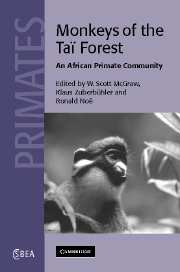Book contents
- Frontmatter
- Contents
- List of Contributors
- Preface
- 1 The monkeys of the Taï forest: an introduction
- Part I Social behavior
- Part II Anti-predation strategies
- 5 Interaction between leopard and monkeys
- 6 Interactions between red colobus monkeys and chimpanzees
- 7 Interactions between African crowned eagles and their prey community
- 8 Monkey alarm calls
- Part III Habitat use
- Part IV Conservation
- Appendix
- Index
- Plate section
- References
7 - Interactions between African crowned eagles and their prey community
Published online by Cambridge University Press: 30 July 2009
- Frontmatter
- Contents
- List of Contributors
- Preface
- 1 The monkeys of the Taï forest: an introduction
- Part I Social behavior
- Part II Anti-predation strategies
- 5 Interaction between leopard and monkeys
- 6 Interactions between red colobus monkeys and chimpanzees
- 7 Interactions between African crowned eagles and their prey community
- 8 Monkey alarm calls
- Part III Habitat use
- Part IV Conservation
- Appendix
- Index
- Plate section
- References
Summary
Introduction
One explanation for the evolution of sociality among vertebrates as an adaptive response to predation pressure. Individuals in groups are able to invest less in vigilance behaviors, are more likely to detect a predator, less likely to be the victim of an attack, and can more effectively mount a defense against a predator. Although there is evidence that individual vigilance levels decline with increasing group sizes in birds and primates (Lima 1987, Cowlishaw 1994), documenting benefits of sociality in terms of predation rates has been difficult in either field or laboratory studies. Group size has been shown to reduce predator capture success in only a few controlled laboratory experiments (e.g. Krause & Godin 1994) or opportunistic field observations (e.g. Lindstrom 1989). Thus despite numerous models predicting how sociality and group size impacts predation risk, there remains little evidence from natural systems to support the theoretical predictions. Through comparing predator diet composition with prey behavioral characteristics we can assess how anti-predator behaviors influence predation rates by different predators.
The different primate species in Taï National Park exhibit a variety of social systems, making the community in Taï an ideal situation to test theories about the relationship between group size, composition, and predation risk. Crowned eagles (Stephanoaetus coronatus), leopards (Panthera pardus), chimpanzees (Pan troglodytes), and humans (Homo sapiens) are the four main predators of primates in Taï.
- Type
- Chapter
- Information
- Monkeys of the Taï ForestAn African Primate Community, pp. 171 - 193Publisher: Cambridge University PressPrint publication year: 2007
References
- 2
- Cited by



